Gaborone
 From Nwe
From Nwe | Gaborone | |
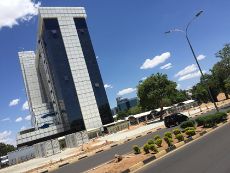
|
|
| Nickname: Gabs, GC, Gabz, G-City | |
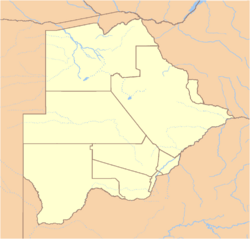
Gaborone
|
|
| Coordinates: 24°39′S 25°54′E | |
|---|---|
| Country | |
| District | Gaborone |
| Sub-district | Gaborone |
| Founded | 1964[1] |
| Named for | Chief Kgosi Gaborone |
| Government | |
| - Mayor | Haskins Nkayigwa (BMD)[2] |
| - Deputy Mayor | Florence Shagwa (BCP)[2] |
| Area | |
| - Total | 169 km² (65.3 sq mi) |
| Elevation [3] | 983 m (3,225 ft) |
| Population (2006) | |
| - Total | 191,776 |
| - Density | 1,134.8/km² (2,939/sq mi) |
| Time zone | Central Africa Time (UTC+2) |
| - Summer (DST) | not observed (UTC+2) |
| Area code(s) | 3XX |
| Twin Cities | |
| - Burbank | |
| - Zhejiang Province | |
| Website: Gaborone City Council Website | |
Gaborone is the capital and largest city of the landlocked nation of Botswana, in Southern Africa. It serves as the administrative capital of Botswana's South-East district. Botswana is considered one of the most economically and politically stable nations on the African continent.
Gaborone lies in a flat valley between Kgale and Oodi Hills, on the Notwane River in southeastern Botswana, about 9 miles (15 kilometers) from the South African border.
Gaborone was founded in 1965, as the capital of Botswana. It is notable that the entire center of the city was constructed within three years. Formerly the British protectorate of Bechuanaland, on September 30, 1966, the country became independent within the Commonwealth of nations. Following its independence, Botswana has maintained one of the world's highest economic growth rates.
Geography
Before 1969, the name of the city was Gaberones, following the early practice of referring to African tribal capitals by the name of the chief, in this case Chief Kgosi Gaborone of the BaTlokwa. The old Gaberones became a suburb of the new Gaborone.
Gaborone lies in the flat valley between Kgale and Oodi Hills, on the Notwane River in the southeastern corner of Botswana, and 15 kilometers (9.3 mi) from the South African border, at an elevation of 2,953 feet (900 meters).
Gaborone has a semi-arid climate which is hot and dry for most of the year. There is little distinction between average summer and winter temperatures, although in winter months it can be chilly at night. Summers are hot with high humidity in the mornings. The average maximum daytime temperature in January is 89.6°F (32°C), dropping to an average maximum of around 73.4°F (23°C) in July. Rain is erratic, but falls mostly in summer in heavy localized downpours. Mean annual precipitation is 20.5 inches (523 mm).
Gaborone was planned as a small town, and its rapid development has necessitated construction of a larger dam to provide an adequate water supply.
A railway line divides the city into two. Suburbs in Gaborone include Broadhurst, Gaborone West, The Village, and Naledi. Phakalane, which is located outside the city's boundaries, has five-star hotels, good restaurants, and a buzzing night life.
The modernist downtown area comprising buildings of glass, steel and bricks, is surrounded by a less-planned lower-rise development. The city is surrounded by villages—Ramotswa to the southeast, Mogoditshane to the northwest, Mochudi to the east, and Tlokweng. Numerous people live in these villages and work in Gaborone.
History
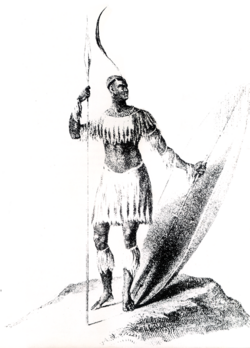
The original inhabitants of southern Africa were the Bushmen (San) and Khoe peoples, who speak click languages and lived as hunters-gatherers. About 1,000 years ago, large chiefdoms emerged, to be eclipsed by the Great Zimbabwe Empire, which spread into eastern Botswana. Around 1300, peoples in present-day Transvaal began to coalesce into three main linguistic and political groups, including the Batswana, who lived as herders and farmers.
The slave and ivory trades expanded during the 1700s, causing resistance, which resulted in the rise of King Shaka, who formed the Zulu chiefdom in 1816.
In the late nineteenth century, hostilities broke out between the inhabitants of Botswana and tribes migrating into the territory from the Kalahari Desert. Tensions also escalated with the Boer settlers (Dutch) from the Transvaal. After appeals by Batswana leaders for help, the British government put "Bechuanaland" under its protection on March 31, 1885. The northern territory remained under direct administration as the Bechuanaland Protectorate, while the southern territory became part of the Cape Colony.
When the Union of South Africa was formed in 1910, out of the main British colonies in the region, the Bechuanaland Protectorate, Basutoland (now Lesotho), and Swaziland were not included, but provision was made for their later incorporation. Although successive South African governments sought to have the territories transferred, Britain kept delaying, and it never occurred.
The election of the South African National Party government in 1948, which instituted apartheid, and South Africa's withdrawal from the Commonwealth in 1961, ended any prospect of incorporation of the territories into South Africa. Botswana was declared a republic on September 30, 1966.
Mafikeng served as capital of the Bechuanaland Protectorate even though it was outside the protectorate's borders, in what is now the North West Province of South Africa, from 1894 until 1965, when Gaborone was made the capital of what was to become Botswana.
The center of the city was constructed in three years, including assembly buildings, government offices, a power station, a hospital, schools, a radio station, a telephone exchange, police stations, a post office, and more than 1,000 houses.
The basic infrastructure was in place for Independence Day on September 30, 1966, when Bechuanaland was the 11th British dependency in Africa to become independent. The first mayor of Gaborone was Reverend J. D. Jones, whose town council led the planning and development of the town in preparation for Independence day.
Government
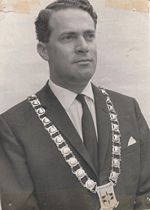
Botswana is a representative democratic republic. The president, who is both the chief of state and head of government, is elected by parliament for a five-year term and is eligible for a second term. The bicameral parliament consists of the House of Chiefs, a largely advisory 15-member body with eight permanent members consisting of the chiefs of the principal tribes, and the National Assembly, comprising 63 members, 57 of whom are directly elected by popular vote.
Gaborone is the administrative capital of the South-East district, which is one of the eight districts of Botswana. Gaborone is one of the three sub-districts of the South East District.
Local government in Botswana is administered by nine district councils and five town councils. District commissioners have executive authority and are appointed by the central government and assisted by elected and nominated district councilors and district development committees. There has been ongoing debate about the political, social, and economic marginalization of the San (indigenous tribal population).
The Southern African Development Community (SADC) has its headquarters in Gaborone. The organization was formed in 1980 to increase economic cooperation among its members and reduce dependence on South Africa.
Economy
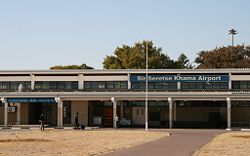
Botswana has maintained one of the world's highest economic growth rates since independence in 1966. Through fiscal discipline and sound management, Botswana has transformed itself from one of the poorest countries in the world to a middle-income country with a per capita gross domestic product of nearly $15,000 in 2007. Two major investment services rank Botswana as the best credit risk in Africa.
Diamond mining has fueled much of the expansion and currently accounts for more than one-third of GDP and for 70-80 percent of export earnings. Tourism, financial services, subsistence farming, and cattle raising are other key sectors. On the downside, the government must deal with high rates of unemployment and poverty. Unemployment officially was 23.8 percent in 2004, but unofficial estimates place it closer to 40 percent.
There is no heavy industry in Gaborone, with motor vehicle assembly plants owned by Hyundai and Volvo closing, citing viability problems.
Gaborone is located on the Cape-Zimbabwe railway. Kombis and taxis ply the routes within the city while buses service surrounding villages and other towns in Botswana. Sir Seretse Khama International Airport lies about six miles (10 km) north of the city and connects with Johannesburg, Cape Town, Harare, Francistown, and Maun.
Demographics
Gaborone's population was 208,411 in 2005. Tswana (or Setswana) make up 79 percent of Botswana's population, Kalanga 11 percent, Basarwa three percent, and other—including Kgalagadi and white—seven percent.
While English is the official language, only 2.1 percent speak it, according to the 2001 census. Most (78.2 percent) speak Setswana, 7.9 percent speak Kalanga, Sekgalagadi 2.8 percent, other 8.6 percent, while 0.4 percent were unspecified.
Regarding religion; Christians made up 71.6 percent of the population in the 2001 census, Badimo six percent, other 1.4 percent, unspecified 0.4 percent, and those with no religion, 20.6 percent.
The University of Botswana, the nation's largest tertiary education provider, which has its main campus in central Gaborone, is a modern, well-resourced campus with a student population of over ten thousand.
The rate of HIV/AIDS infection in Botswana was 24 percent for adults in 2006.[4] In 2003, the government began a comprehensive program involving free or cheap generic anti-retroviral drugs as well as an information campaign designed to stop the spread of the virus.
Places of interest
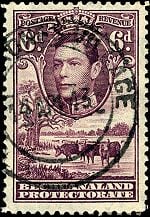
Sights of interest in Gaborone include:
- The Main Mall, which is the heart of Gaborone, with shops, banks, business offices, as well as walkway with people selling crafts and other goods.
- The Civic Centre, located at the eastern end of The Mall, houses a public reference library. * The Pula Arch, which is a landmark that commemorates the Independence of Botswana.
- The National Assembly, located at the top of the Main Mall, where it is surrounded by the other tall government buildings.
- The War Memorial, located at the center of the government area, in memory of the 300 Batswana who died fighting with the Allies against Fascism in World War II (1939-1945).
- Kgale Hill, on the western edge of the city, offers breathtaking views of the dam and city.
- The the St. Claire Lion Park, which is set in open woodland 8.6 miles (14km) from Gaborone, includes a restaurant, bar, extensive children's playground, horse trails, motorbike rides, a vulture restaurant (where Otse's Cape vultures are fed), three dams, picnic sites, and camping grounds, as well as viewing of the lions.
Looking to the future
Gaborone is a young city that has the unique position of being the capital of one of the most economically and politically stable nations on the African continent. However, Botswana's four decades of uninterrupted civilian leadership, and progressive social policies, is somewhat undermined by the fact that it has one of the world's highest known rates of HIV/AIDS infection. This is somewhat balanced out because it also has one of Africa's most progressive and comprehensive programs for dealing with the diseases.
Notes
- ↑ Parsons, Neil (1999-08-19). Botswana History Page 7: Geography. Botswana History Pages. University of Botswana History Department. Retrieved April 18, 2012.
- ↑ 2.0 2.1 Keoreng, Ephraim (2011-10-05). New Gaborone Mayor seeks power to hire and fire. Mmegi Online. Retrieved April 18, 2012.
- ↑ Gaborone, Botswana Page. Falling Rain Genomics, Inc.. Retrieved April 18, 2012.
- ↑ Joint United Nations Programme on AIDS, 2006 Report on the global AIDS epidemic Retrieved November 15, 2008.
References
ISBN links support NWE through referral fees
- Bennett, Bruce. A note on place names, historical terms, etc. University of Botswana History Department. Retrieved October 19, 2022.
- Botswana, R. M. Key, and K. Jennings. Gaborone. Lobatse: The Dept., 1980.
- Denbow, James R., and Phenyo C. Thebe. Culture and customs of Botswana. Culture and customs of Africa. Westport, CT: Greenwood Press, 2006. ISBN 978-0313331787.
- Greenway, Paul. Botswana. Melbourne, Vic: Lonely Planet, 2001. ISBN 978-1740590419.
- Molebatsi, C. O. "Towards a Sustainable City: Gaborone, Botswana." AMBIO -STOCKHOLM-. 25 (2) (1996): 126-133.
- Pons, Alain, Christine Baillet, and Heather Angel. Botswana. Safari companions. Rickmansworth: Evans Mitchell, 2006. ISBN 978-1901268225.
- Wiseman, John A. Botswana. World bibliographical series, v. 150. Oxford, Eng: Clio Press, 1992. ISBN 978-1851091713.
|
|||||||||||||
Credits
New World Encyclopedia writers and editors rewrote and completed the Wikipedia article in accordance with New World Encyclopedia standards. This article abides by terms of the Creative Commons CC-by-sa 3.0 License (CC-by-sa), which may be used and disseminated with proper attribution. Credit is due under the terms of this license that can reference both the New World Encyclopedia contributors and the selfless volunteer contributors of the Wikimedia Foundation. To cite this article click here for a list of acceptable citing formats.The history of earlier contributions by wikipedians is accessible to researchers here:
- Gaborone history
- Botswana history
- History_of_Botswana history
The history of this article since it was imported to New World Encyclopedia:
- History of "Gaborone"
Note: Some restrictions may apply to use of individual images which are separately licensed.
↧ Download as ZWI file | Last modified: 02/03/2023 23:07:37 | 17 views
☰ Source: https://www.newworldencyclopedia.org/entry/Gaborone | License: CC BY-SA 3.0
 ZWI signed:
ZWI signed: KSF
KSF